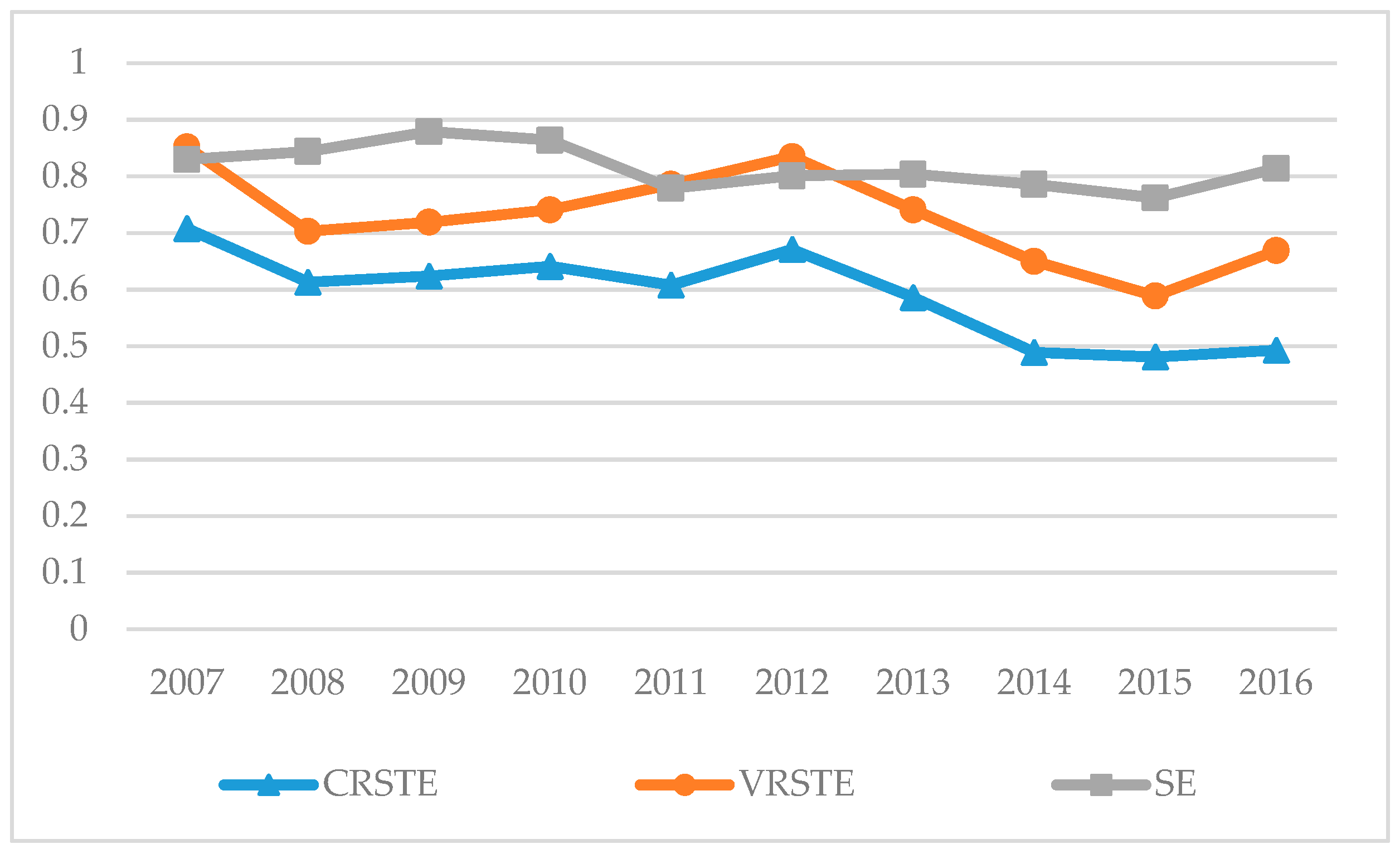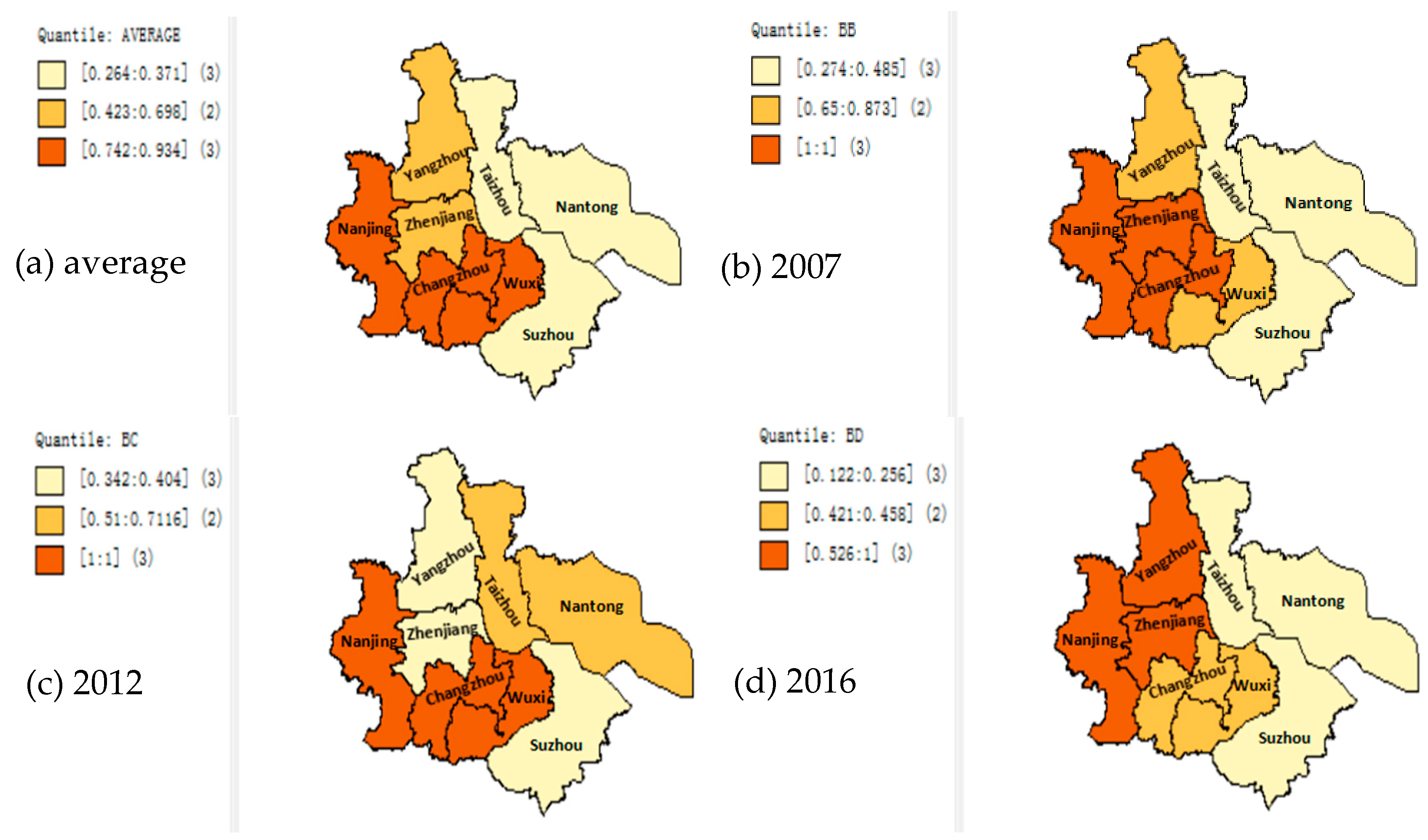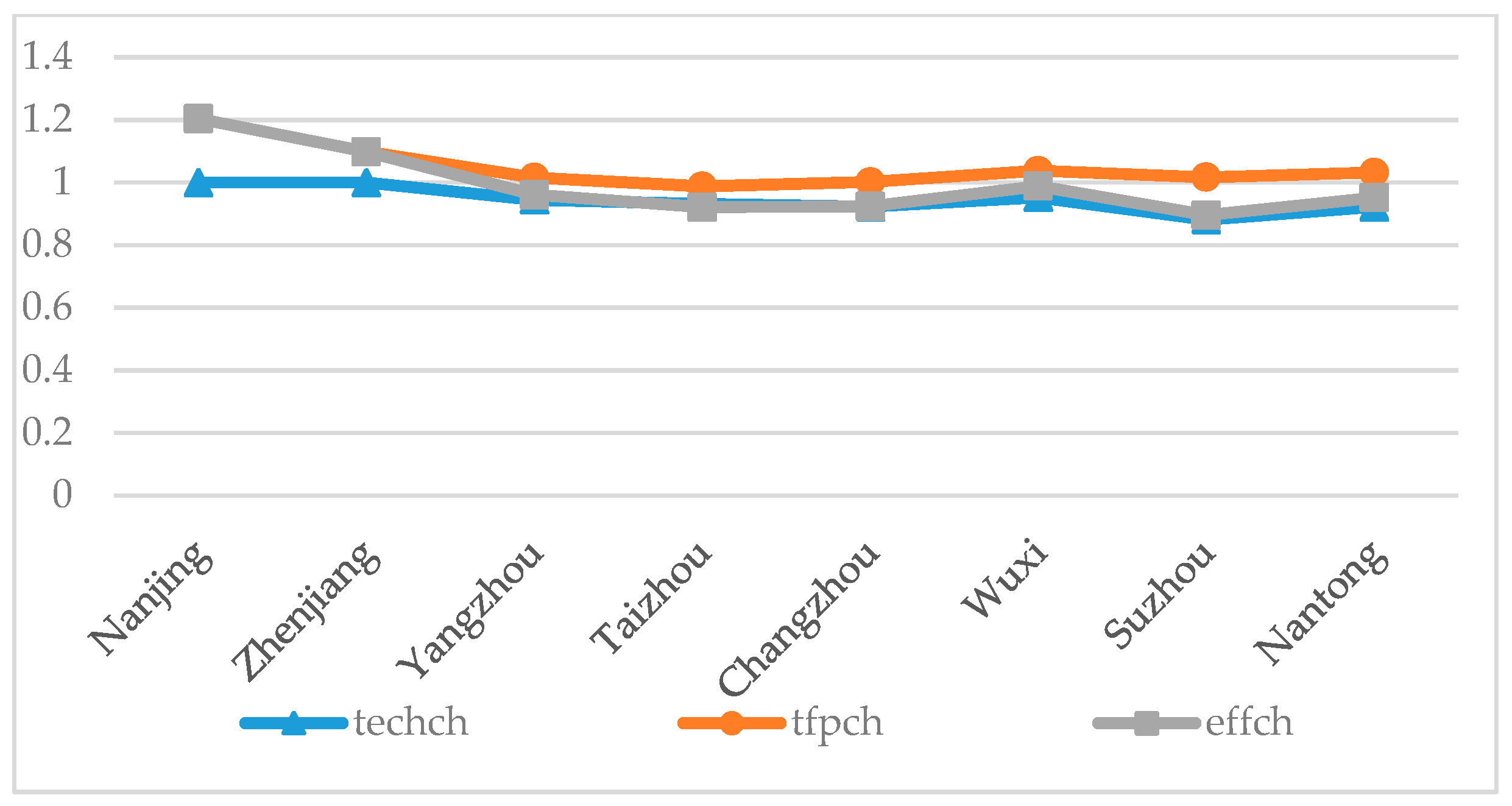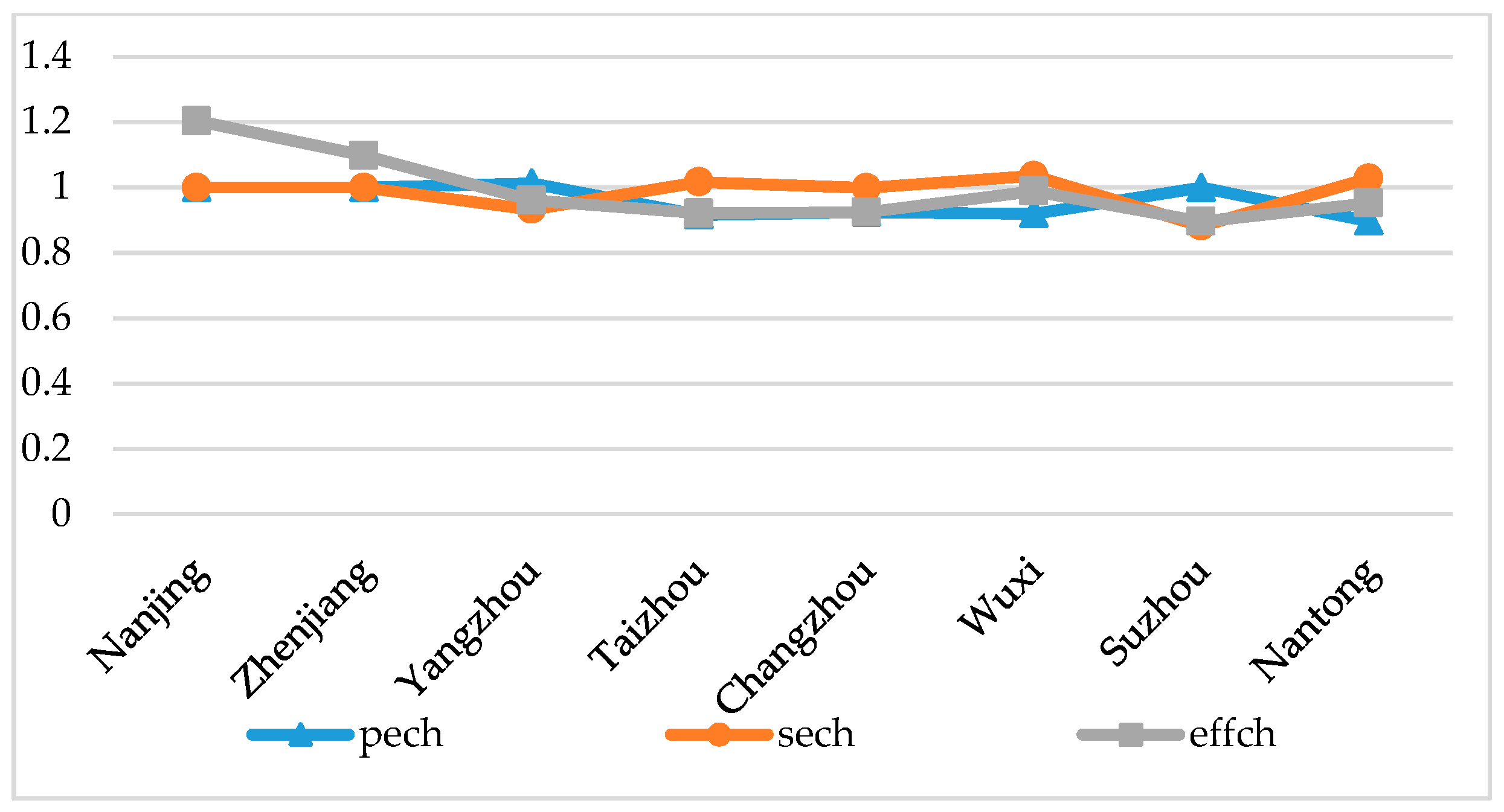1. Introduction
Accompanying the accelerated advancement of the global economy, the problem of urban environmental governance has become the focus of all countries. In fact, as early as 1992, the World Organization for Sustainable Development had already targeted the problem by proposing the concept of “environmental efficiency” to measure the environmental costs of urban economic development.
In the context of global attention to environmental issues, achieving environment-friendly economic growth is imperative for many fast developing countries. In China, accompanied by the astonishing development of urban industrialization, numerous urban agglomerations of different sizes have formed so far, such as the Yangtze River urban agglomeration or the Pearl River urban agglomeration. However, under the condition of limited environmental carrying capacity, the environmental problems caused by both the population aggregation and the industrial development are constantly increasing the pressure of environmental governance in urban agglomerations and have become a prominent social issue that affects the production and life of urban residents.
Consequently, studying the environmental governance of urban agglomeration is an important exploration of environmental issues in the process of urbanization. The analysis of the environmental conditions of the Yangtze River, which is the longest river system in the country, crossing 31 provinces, is of great significance to other urban agglomerations facing the same problems.
At present, research on environmental governance at home and abroad is mainly focused on:
(1) Environmental Governance Efficiency (EGE)
Gan and Wang [
1] (2013) used the Data Envelopment Analysis (DEA) model, and Malmquist index to calculate the EGE and dynamic change of the Yangtze River Delta cities, a coastal area in eastern China, 51,000 square kilometers that includes Nanjing, Zhenjiang, Yangzhou, Taizhou, Changzhou, Wuxi, Suzhou, Nantong, with a population of 50 million. They found that the EGE appeared generally higher and fluctuating upward in the Yangtze River Delta.
Zaim O [
2] (2000) used nonparametric techniques to measure the EGE of Organisation for Economic Co-operation and Development, formulated an EGE index, and compared pollution control across countries. The results showed that strict limit on carbon emissions will lead to output losses. Mandal, Madheswaran [
3] (2007) used DEA to measure the EGE of India in a joint production framework. The results showed that the cement industry may expand the desired production and shrink the unfavorable output in the face of environmental regulation. Van Leeuwen, Koop, and Sjerps [
4] (2016) made a baseline assessment of water resource governance in Europe and found that cities in transitional and developing countries are prone to water risk. Tang, Zhang, and Liu [
5] (2016) used the slackness measurement (SBM) poor model to analyze the efficiency of environmental regulation. The results showed that environmental regulation efficiency presented a “polarization” effect and the environmental regulation total factor productivity had a clear “aggregation” effect in China.
(2) Environmental governance research methods
Reinhard et al. [
6] (2000) used the Stochastic Frontier Approach and Data Envelopment Analysis (DEA) to estimate the comprehensive EGE measures and compared the two methods. The results showed that DEA is more suitable for calculating the EGE scores of all specifications. Luo [
7] (2012) proposed an EGE evaluation method based on slack variables, which was applied to the efficiency of industrial environment in China. It was found that about two-thirds of the decision-making units were not effective. Tang et al. [
8] (2012) constructed a low carbon manufacturing evaluation index system and proposed evidence for industrial policy innovation based on this evaluation system. Tu and Qiu [
9] (2013) based their research on the DEA-based directional distance function method to examine China’s industrial EGE and found that environmental technology efficiency assessed by traditional techniques underestimated the EGE. Kuosmanen and Entertainer [
10] (2015) evaluated how Data Envelopment Analysis aggregated environmental pressures into a single environmental damage index by assessing the EGE of urban road transport in eastern Finland. Koop [
11] (2017) analyzed the water, waste, and climate change challenges of cities, and used an empirical method to achieve consistent comparisons between cities and then proposed governance options.
(3) Environmental governance policy
Gunningham [
12] (2009) examined the relationship between old and new governance from the perspective of three Australian case studies, and revealed the importance of the state in the “shadow of hierarchy”. Tang [
13] (2012) pointed out the challenges faced by China’s low-carbon manufacturing industry and proposed related countermeasures through comparison of China’s energy consumption with other countries. Bruce and William [
14] (2014) reviewed the dynamic change in China’s local environmental governance and proposed solutions to the problems of “policy implementation gap” and “participation gap”. Kitagawa, Geng [
15] (2017) has studied China’s environmental governance policy pipeline since 1979, and believes that implementing environmental governance policies should be centered on local governments. From the four aspects of legal, management, governance mechanism, and policy, Tang [
16] (2017) combed the refined governance system formed by Japan in the process of environmental governance, and proposed the improvement path of China’s environmental governance. The above scholars’ research methods are relatively simple, failing to fully reflect the status of efficiency development. The area of research objects is relatively extensive; the research on urban agglomerations as an object and urban EGE data as indicators is not sufficient, and the study of EGE in large regions does not reflect the heterogeneity of regional development. Furthermore, it lacks of space-time analysis of efficiency differences and the study of the trend of efficiency development.
This article uses data from 8 cities of the Yangtze River urban agglomeration from 2007 to 2016 to build a DEA model, for calculating the efficiency of environmental management. On one hand, it comprehensively analyzes the environmental governance of the Yangtze River urban agglomeration; by contrast, it also deconstructs the EGE to compare and analyze the spatial and temporal differences in EGE among cities, and further discusses relevant factors affecting the EGE of the Yangtze River urban agglomeration, expecting to fill the gap in space-time differentiation study and to provide useful ideas for the governance of urban agglomerations.
In the remainder of this article, the contents are arranged in the following way:
Section 2 introduces the DEA model and data sources, and establishes an EGE indicator system.
Section 3 analyzes the difference of EGE between cities within the Yangtze River urban agglomeration from the perspective of time and space, and uses the Malmquist exponential decomposition to investigate the impact of various indicators on EGE.
Section 4 uses the Tobit regression model to analyze the magnitude and impact of important factors affecting the EGE of cities in the Yangtze River urban agglomeration. In
Section 5, we summarize the environmental management efficiency of the Yangtze River urban agglomeration and give relevant suggestions.
2. Research Methodology
In this section, we study the rationality of the data envelopment analysis (DEA) method for our problem and examine the data sources. Subsequently, we construct an EGE index system based on the ecological status regarding the Yangtze River urban agglomeration for exploring influencing factors of EGE.
2.1. DEA Model
DEA, or data envelopment analysis, is a research method proposed by well-known American researchers Charnes, Copper, and Rhodes in 1978 to evaluate efficiency among samples [
17] (Charnes, Cooper, Rhodes, 1982). When using the DEA model for efficiency calculation, an indicator system and a decision unit [
18,
19] (DU) (Fare and Grosskopf, 1986; Huppes and Ishikawa, 1986) (Decision Making Units, DMU) should be established: If efficiency is 1, the output of the DU is on the frontier boundary, which indicates that the input is effective; if efficiency is less than 1, the output of the DU is at a distance from the frontier boundary, which means that there is still some distance between the effect of investment and the ideal result. Specifically, DEA is a model that uses mathematics planning to establish evaluations, determines relatively effective production frontiers, and projects each DU onto the production frontier. The relative effectiveness of each DU is compared by the distance from the DU to the production frontier [
20] (Wang, et al., 2010). The specific model formula is as follows:
where
x is a single input to the production unit,
X is the input vector of the production unit, m is the quantity of production inputs
x,
y is a single output, and
Y is the output vector of the production unit.
is the efficiency value,
stands for the amount of excess redundancy,
means that the expected output is insufficient,
stands for an excess surplus of an undesired output, and λ denotes the weight of input and output.
When and , or , or , the DMU is an effective unit of EGE.
When and , or , or , it is a weakly effective unit, that is, while it reduces the input of redundant production unit , the output of does not change.
When , it is an invalid unit of EGE, that is, reducing the original input can leave the production unit output unchanged. If the DMU is improved to be an effective unit, it requires some improvements in input, expectation, and unintended output.
2.2. Data Sources and Indicators Selection
The data used in this paper come from Jiangsu Environmental Statistics Annual Report (2008–2017), Environmental Status Bulletin (2007–2016), Environmental Statistical Yearbook (2008–2017), and Statistical Yearbook (2008–2017). We selected 80 pairs of environment-related data from 2007 to 2016 for the DEA model, and 5 indicators from each set of data.
At present, urban environmental governance is dominated by the governments in different administrative regions, and environmental governance in each region is relatively independent. Therefore, the environmental governance process in each administrative region of the Yangtze River urban agglomeration can be regarded as a DU (Fare R, 1986). The environmental governance economic investment is the input of DMU. The EGE is taken as the output of DMU. The EGE is determined by the intended output and unintended output, both caused by the input of environmental governance. Since DEA theory requires that the number of indicators between input and output is less than or equal to half the total number of DMUs in the DU [
21] (Guo and Zheng, 2009), we selected the environmental capital investment as the input variable, GDP as the expected output index, and the regional emissions, waste water discharge, and unprocessed industrial solid waste as unintended output indicators, for the following considerations:
1. They have sufficient literature support.
References Gai et al. (2014), Li Min (2017), Wu H Q et al. (2014) used these five indicators to construct an evaluation system for environmental governance efficiency, which verified the rationality of these five indicators.
2. They are representative.
Capital investment is the most important investment in environmental protection, and economic level is an important indicator of efficiency. Waste water and solid waste are the main sources of environmental pollution. Therefore, we used GDP as the expected output, and used the waste water, waste gas, and solid waste as undesired outputs.
Subsequently, a three-level, three-dimensional index evaluation system was formed (
Table 1). At the same time, the urbanization level, industrial structure, economic development level, urban construction, population density, and capital openness index were selected to study the influencing factors of EGE for the Yangtze River urban agglomeration. The descriptive statistical characteristics of input and output are shown in
Table 2.
4. Influencing Factors of EGE
After obtaining the calculation results from the DEA model, it was found that the EGE of the Yangtze River urban agglomeration is also affected by other factors, in addition to the output indicators. Therefore, we selected other indicators as the main influencing factors of EGE and analyzed the effects of these influencing factors on EGE using the Tobit regression model.
4.1. Main Influencing Factors of EGE
The EGE of the Yangtze River urban agglomeration, which was previously calculated using the DEA model, is also affected by other factors than the output indicators of Malmquist model. To further analyze the influencing factors of EGE, the aspects listed below are selected as the main influencing factors of EGE on the basis of development status of the Yangtze River urban agglomeration (
Table 6):
4.2. Tobit Regression Study
The Tobit regression model can be used to solve regressions with restricted conditions. The regression equation is given as follows [
30,
31] (Tobin, 1956; Coelli, 1998):
In the Equation, is a potential variable, observed when the latent variable is greater than 0, and the value is , truncate at 0 when it is less than or equal to 0; is an independent vector, is a coefficient vector, the error term is independent and obeys the normal distribution: .
A metrology analysis software Eviews (Microsoft, Redmond, WA, USA) was used to make a unit root test; the indicators were brought into Eviews for Tobit regression (
Table 7).
The Tobit regression results indicate that the significance of the urbanization level and capital openness has not passed the test, which is to say that its effect on the EGE is not very obvious. Therefore, removing both of them for Tobit regression again, we have obtained the following results (
Table 8).
The economic development level and urban construction have an adverse effect on the EGE at the significant level of 10% and 1%. For every 1% increase in per capita GDP, the EGE drops by 3.05 × 10−6%; for every 1% increase in investment in infrastructure construction, the EGE will decline by 9.496233%. Industrial structure and population density have a favorable effect on the EGE at the significant level of 5% and 10%, respectively. For every 1% boost in the GDP of the tertiary industry, the EGE will increase by 2.208085%; for each 1% increase in population density, the EGE will increase by 6.52 × 10−5%.
4.3. Analysis and Discussion of Results
The economic development level and urban construction have an adverse effect on the EGE. However, the overall income level of the Yangtze River urban agglomeration is at the top of the country, but the EGE is at the middle-to-upper level. Although the income level increases, the ability to generate pollutants also increases, and the generated domestic garbage has not been properly disposed of, resulting in a decrease of urban EGE. That is, the ability to produce pollution has increased, but the awareness of protecting the urban environment has not been strengthened. With the increase of the construction for urban infrastructure, more pollutants will be generated and more resources will be needed to deal with them, which will inevitably reduce the urban EGE.
The industrial structure has a beneficial effect on the urban EGE. As an important developing area in Jiangsu province, the Yangtze River urban agglomeration has always been dominated by the tertiary industry. Suzhou and Nanjing are high-tech cities. Wuxi and Nantong mainly develop the textile industry. Therefore, vigorous improvement of the tertiary industry is conducive to the EGE. Additionally, the service industries, such as scientific research design, logistics industry, and financial industry in the tertiary industry, contribute to the positive effect of productivity and EGE. However, the low EGE in Suzhou is primarily affected by excessively invested on but inadequately utilized resources in environmental protection.
Population density has a beneficial effect on the urban EGE. Nanjing is the most obvious example. More and more laborers in other provinces are pouring into Nanjing, which greatly increases the population density of Nanjing. However, the EGE of Nanjing is the highest in the Yangtze River urban agglomeration. The reason is that the population density has brought about the improvement of living standards and education. The increase in education level, economic growth, and awareness of environmental protection should be greater than the environmental pressure. Therefore, large immigration numbers are in fact conducive to the improvement of urban EGE rather than having a negative effect.
The level of urbanization and the capital openness have no significant effect on the EGE of the Yangtze River urban agglomeration. This shows that in improving urban environmental governance measures, the level of urbanization and capital openness are not the main factors to consider.
5. Conclusions
5.1. Conclusions and Suggestions
In general, the EGE of the Yangtze River urban agglomeration is relatively low. There are 4 cities with relatively high efficiency, namely Nanjing, Changzhou, Wuxi, and Zhenjiang, of which Nanjing has the highest efficiency, as high as 0.934; 4 cities have relatively low efficiency, namely Yangzhou, Suzhou, Taizhou, and Nantong, of which Nantong has the lowest efficiency, as low as 0.246.
Judging from the time dimension, the overall EGE of the Yangtze River urban agglomeration is in the upper middle level. In 2007, the EGE reached its maximum value, and then the index gradually decreased. Since 2012, the EGE index has rapidly declined. In the course of economic development, we should improve the environmental management agencies and strengthen the management and supervision of urban environmental governance to ensure that the EGE is gradually improved, instead of promoting the development of urban economy at the expense of the environment.
Judging from the spatial perspective, the urban development in the southern part of Jiangsu is relatively fast, and the EGE is also high. The urban development in northern Jiangsu is relatively lagging behind, causing greater damage to the environment and a lower EGE. Therefore, it is necessary to construct the exchange system of the Yangtze River urban agglomeration with a shared concept, in order to achieve interconnection and interoperability among the eight cities, and to promote environmental governance in coordination.
According to the DEA-Malmquist index decomposition analysis, the EGE of the Yangtze River urban agglomeration is basically driven by tfpch, and the seffch is the main driver of tfpch. Suzhou and Nantong have invested much more in environmental governance than other cities, but the EGE is the last. The main reason is that environmental governance technology is not mature and capital investment has little effect. Therefore, it is particularly important to accelerate the development of science and technology. The Yangtze River urban agglomeration needs to improve technological innovation capabilities; accelerate the elimination of backward and immature environmental technologies; and communicate actively with other environmentally more efficient regions and introduce advanced environmental protection technologies.
From the Tobit regression research analysis, it is concluded that urbanization level and capital openness have no significant impact on urban EGE; the economic development level and urban construction have an adverse impact on urban EGE; and industrial structure and population density have a beneficial impact on urban EGE. Therefore, optimizing industrial structure during the development of the Yangtze River urban agglomeration has a positive effect on improving regional environmental quality. Transferring energy-intensive and highly-polluting enterprises to knowledge-intensive and environment-friendly industries can enhance the harmonious advancement of the economy and environment. In addition, the population density has a beneficial effect on the efficiency of urban environmental governance. Therefore, the government should encourage the public to join the environmental management, through the three-party supervision of the government, enterprises, and the public to promote the improvement of urban EGE.
5.2. Study Limitations and Prospects
Although we tried to select influencing factors comprehensively and systematically, it is inevitable to have some missed considerations and it is difficult to cover all the factors affecting the EGE. In addition, we have only studied the efficiency of China’s interprovincial environmental governance from a macro perspective. Due to the lack of more specific industry characteristics, it is difficult to provide targeted policy recommendations for different industries. Therefore, the next step is to study the EGE of various industries, to explore the mechanism of environmental governance-influencing factors from a micro perspective, to provide a deeper industry foundation for China’s EGE, and thus to formulate more practical policy guidance for microproducers.










